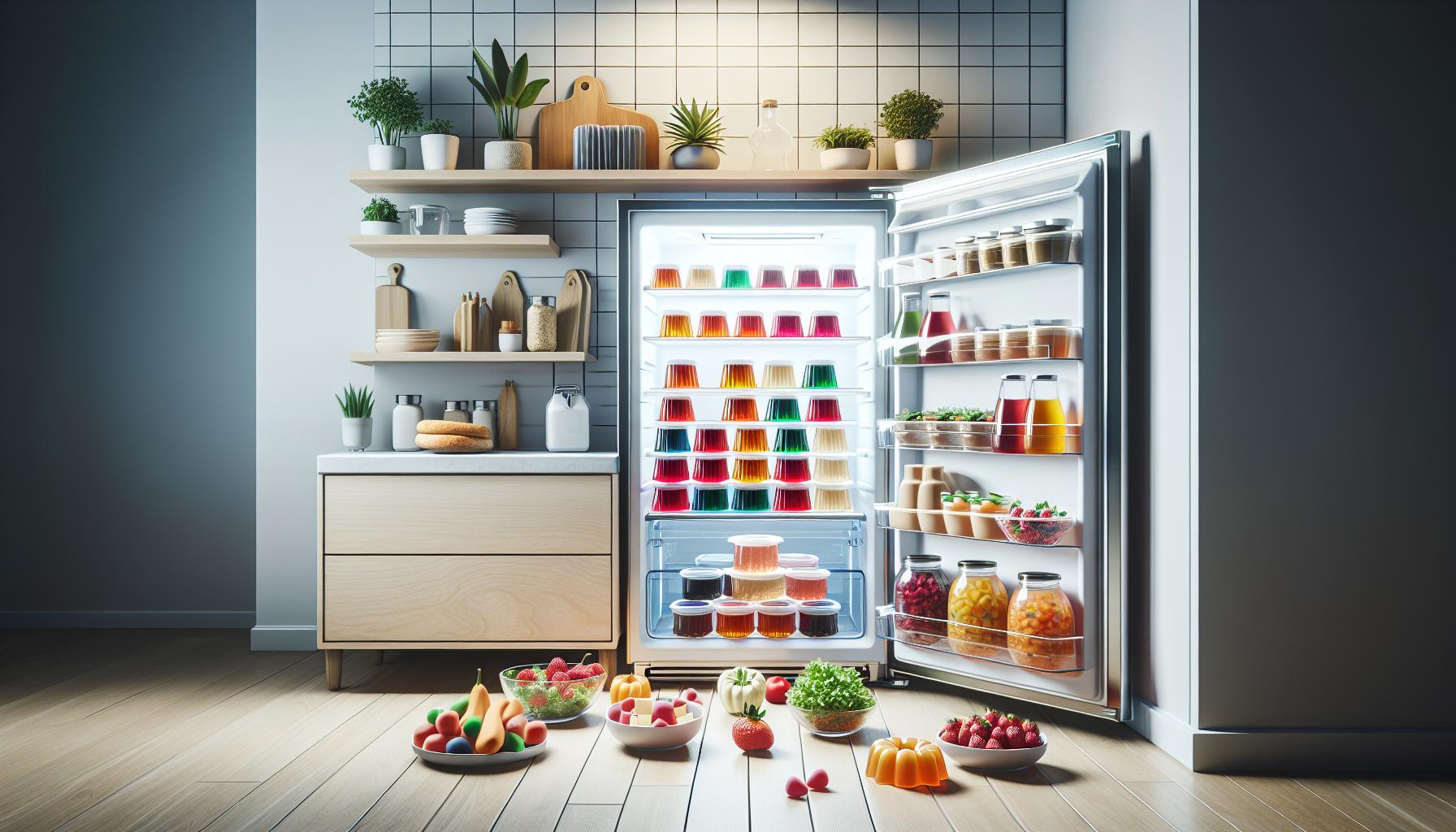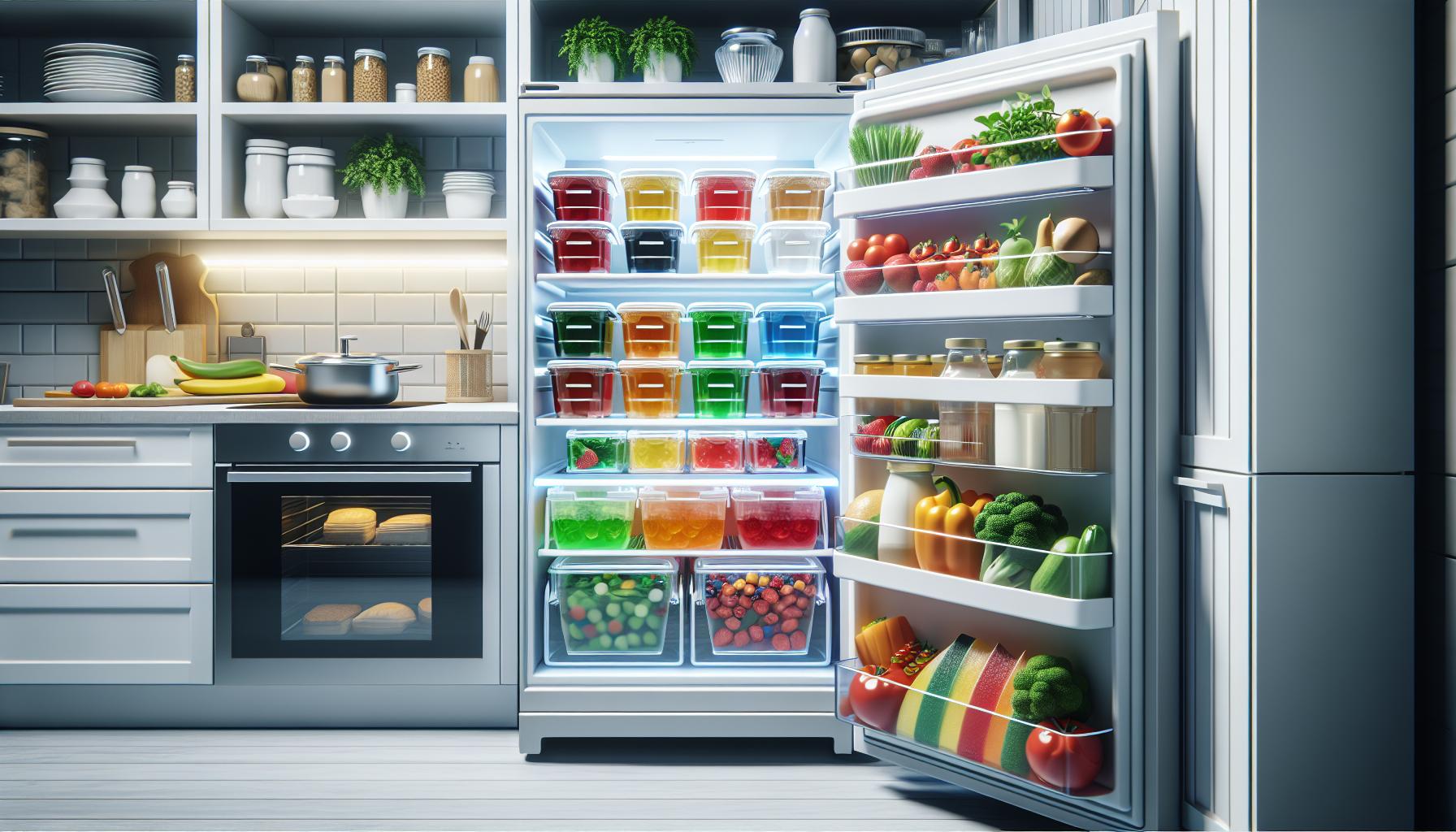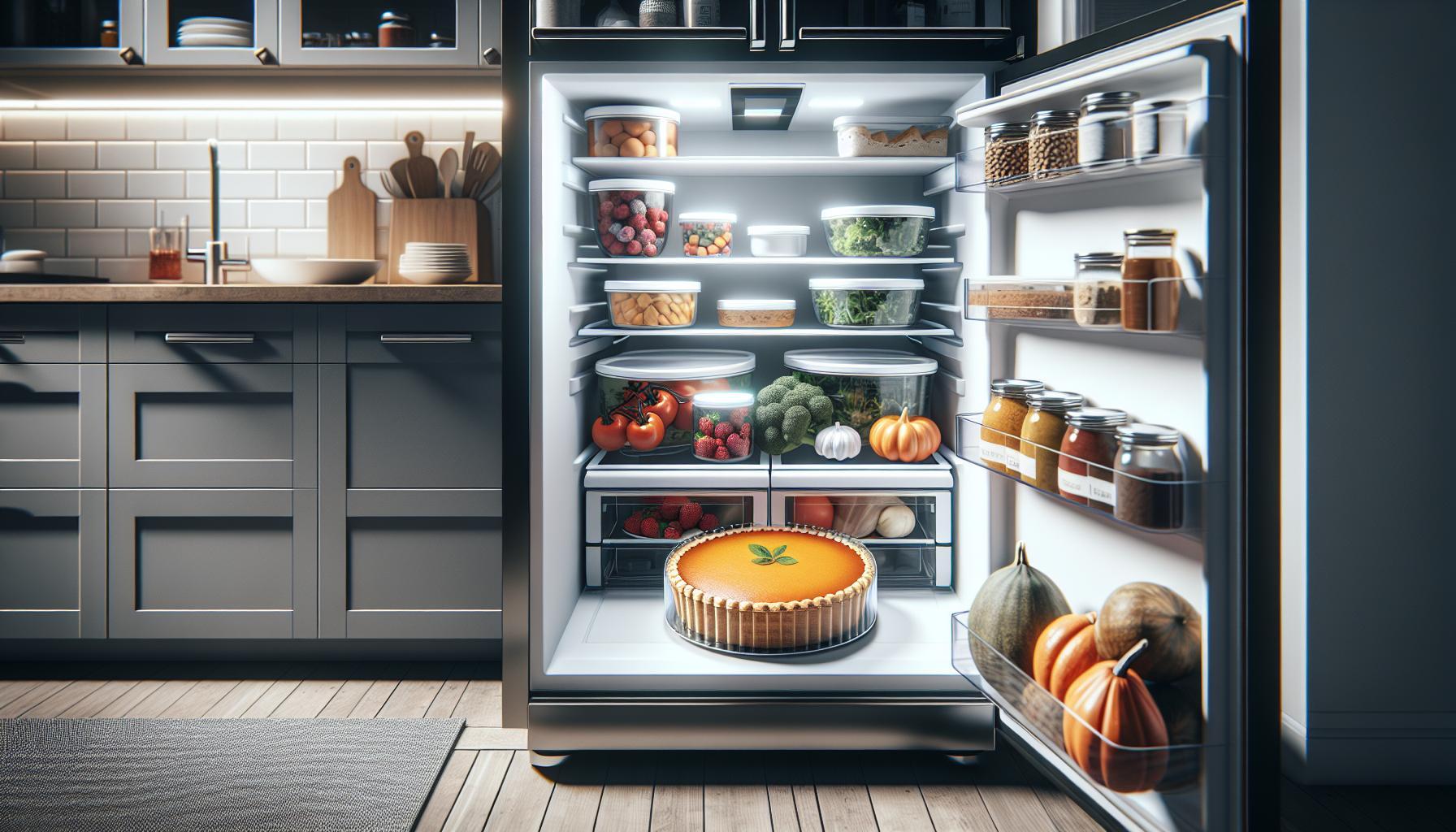Did you know that Jell-O, the classic wobbly dessert, can last in the fridge for several days, allowing you to enjoy its delightful flavors without worry? Understanding how long Jell-O stays fresh not only enhances your culinary confidence but also ensures food safety in your kitchen. Whether you’re preparing for a family gathering or simply indulging in a sweet treat, knowing the right storage guidelines can help you maximize freshness and flavor.
Many home cooks often ask themselves, “Is this Jell-O still good?” With the right information, you can easily navigate these concerns and enjoy your favorite gelatin desserts to the fullest. In this article, we’ll explore how long Jell-O lasts in the fridge, along with tips on proper storage and signs to look out for to ensure that your wobbly dessert remains safe and delicious. So, let’s dive into the world of Jell-O and leave your worries behind!
How Long Can You Keep Jello in the Fridge?
Jell-O, with its vibrant colors and wobbly texture, is a beloved treat that can bring joy to any occasion. When stored properly in the refrigerator, Jell-O can typically last for about 1 to 2 weeks after it has been prepared. The exact duration, however, can vary based on several factors, including the ingredients used and how well it has been stored.
To ensure you get the most out of your Jell-O, it’s essential to keep it sealed in an airtight container. This not only prevents it from absorbing odors from other foods in your fridge but also helps maintain its texture. If your Jell-O has been served and sits at room temperature, try to refrigerate any leftovers within 2 hours to reduce the risk of bacterial growth.
It’s also worth noting that homemade Jell-O may spoil faster than store-bought versions due to its lack of preservatives. Pay attention to the “best by” dates on packets, as they can indicate how long the dry mix will retain its quality, although once mixed, the 1 to 2 weeks rule applies. To enjoy your Jell-O at its best, keep an eye on its appearance and smell; if it looks off or has developed an unusual odor, it’s safer to discard it.
Understanding Jello Shelf Life: Key Factors

Jell-O’s appeal lies not only in its bright colors and playful wobble but also in its relatively simple preparation and storage. Understanding how long it lasts hinges on various factors, including its ingredients, how it’s made, and storage conditions. Once prepared, Jell-O is typically good in the fridge for about 1 to 2 weeks, but variables such as temperature fluctuations and contamination can influence this timeframe.
One of the critical elements affecting Jell-O’s shelf life is its moisture content. Jell-O is primarily water, and as it sits, it can absorb odors and flavors from other foods. To combat this, always store it in an airtight container. This will not only help preserve its flavor but also prevent it from getting watery or developing an undesirable texture. Additionally, homemade Jell-O, which often lacks the preservatives found in commercial varieties, tends to spoil more quickly. Thus, if you’ve whipped up a fresh batch, keep an eye on it and consume it sooner than later, ideally within that 1 to 2-week window.
Moreover, be mindful of temperature. Jell-O should be kept at a consistent refrigerator temperature, ideally below 40°F (4°C). Leaving Jell-O out at room temperature for over two hours can increase the risk of bacterial growth, making it unsafe to eat. It’s also important to consider that ingredients added to your Jell-O, such as fruit or whipped cream, can shorten its shelf life due to the potential for faster spoilage.
Ultimately, enjoying Jell-O at its best involves a combination of proper preparation and mindful storage practices. Keep track of how long it’s been since you made it, watch for changes in texture or odor, and when in doubt, it’s safer to discard any questionable remnants.
Signs That Jello Has Spoiled

When indulging in Jell-O, it’s essential to recognize the signs that your delightful dessert may have gone bad. Spoiled Jell-O not only loses its wobbly appeal but can also pose health risks if consumed. Understanding what to look for can help you enjoy this treat safely and prevent unwanted surprises.
One of the most noticeable indicators of spoiled Jell-O is a change in texture. If your once smooth and gel-like dessert has developed a watery layer on top or feels overly soft and mushy, it’s a clear sign that it is no longer good. Additionally, look for any signs of mold, which can appear as fuzzy spots or a slimy coating. If you spot mold, it’s best to discard your Jell-O entirely, as even scraping off the mold does not ensure it’s safe to eat.
Another critical aspect to monitor is the smell. Fresh Jell-O has a sweet, fruity scent that is pleasant and inviting. If you detect a sour or off-putting odor, it’s a strong indication that your Jell-O has spoiled. This change in smell can occur due to the breakdown of ingredients over time, particularly in homemade varieties lacking preservatives.
Lastly, it’s important to note any alterations in color. While Jell-O naturally has vibrant hues, dullness or discoloration can suggest spoilage or absorption of odors from other foods in the refrigerator. If in doubt, always err on the side of caution. When you notice any of these signs-texture changes, odd smells, or color alterations-it’s safer to throw the Jell-O away than risk your health.
Proper Storage Techniques for Jello
To ensure that your Jell-O stays fresh and maintains its delightful wobble, proper storage techniques are crucial. Jell-O can last in the refrigerator for about 7 to 10 days once it has set. To maximize its shelf life while retaining that signature texture, follow these essential storage guidelines.
Firstly, use an airtight container to store your Jell-O. Whether it’s homemade or store-bought, transferring it to a container with a tight seal keeps out moisture and odors, which can compromise the dessert’s quality. Plastic food containers or glass jars with lids work well for this purpose. If the Jell-O isn’t already cut into servings, avoid covering it directly with plastic wrap or foil, as these materials can lift off some of the surface gelatin, impacting the texture. Instead, opt for a container that will comfortably fit the Jell-O without needing to press down on the lid.
When placing your Jell-O in the refrigerator, make sure it’s stored on a stable shelf rather than in the door. The temperature fluctuations in the door can affect its consistency. Keep your fridge set to below 40°F (4°C), as this temperature range is ideal for perishable items. If you notice that your Jell-O has been in the fridge for several days, it’s a good practice to check for any signs of spoilage before consuming it.
Another key technique to extend the life of your Jell-O is to avoid exposure to heat or sunlight. Store it in a part of the fridge that is shielded from light, as ultraviolet rays can degrade the coloring and flavor over time. Additionally, avoid placing your Jell-O near foods with strong odors, as it can easily absorb those scents, affecting its pleasant flavor. By taking these simple steps, your Jell-O can provide enjoyment and freshness throughout its intended shelf life.
How to Extend Jello’s Freshness
To keep your Jell-O fresh and vibrant for as long as possible, employing specific strategies during storage can significantly extend its shelf life. One simple yet effective method is to ensure that your Jell-O is in an airtight container immediately after it has set. This prevents moisture from seeping in and protects the dessert from absorbing unwanted odors present in your refrigerator, which can alter its flavor.
Optimal Storage Conditions
The ideal environment for Jell-O is a consistent temperature below 40°F (4°C). A stable temperature helps maintain its texture and prevents premature spoilage. It’s best to place the Jell-O on a middle shelf instead of the refrigerator door, where temperature fluctuations occur more frequently. To provide an additional layer of protection against light and contamination, consider wrapping the container in aluminum foil or placing it in a dark-colored storage bin.
Preventing Surface Degradation
Air exposure can lead to surface degradation of Jell-O. To mitigate this, ensure that the container seals tightly and is not overcrowded, allowing air circulation. If you find that your Jell-O is frequently accessed, consider portioning it out into smaller servings stored in separate containers. This not only maintains its freshness but also makes it convenient for serving.
Careful Handling of Leftovers
After cutting into Jell-O, the exposed surfaces are more vulnerable to spoilage. To further extend freshness, cover cut edges with a bit of plastic wrap before sealing it in the airtight container. Additionally, avoid placing your Jell-O near foods that have strong odors, such as onions or garlic, as Jell-O can easily absorb these scents, compromising its delightful taste.
Following these guidelines can effectively prolong your Jell-O’s life, allowing you to enjoy its wobbly goodness for up to 10 days. By maintaining the right conditions and handling your dessert with care, you can minimize waste and savor every delightful bite.
Freezing Jello: A Complete Guide
Freezing Jell-O can be a game changer for preserving your favorite dessert, but it requires a few considerations to ensure you maintain its unique texture and flavor. While Jell-O can last up to 10 days in the refrigerator when stored properly, the freezing process can extend its shelf life significantly. However, it’s important to note that freezing can alter the texture of Jell-O, making it slightly grainy or watery when thawed. Therefore, understanding how to freeze and thaw Jell-O properly will help you enjoy its delightful wobbliness for longer.
To freeze Jell-O, start by ensuring it has fully set and is in an airtight container. Proper sealing is crucial as it prevents freezer burn and protects against absorption of unwanted odors. You can also consider portioning Jell-O into smaller servings using freezer-safe containers or ice cube trays. This approach not only maximizes space in your freezer but also allows for easy thawing of just the right amount when you crave a snack. Jell-O can typically remain frozen for up to 2 months while retaining its flavors, provided the right conditions are maintained.
When it comes to thawing, patience is key. The best method is to transfer the frozen Jell-O to the refrigerator and let it thaw slowly overnight. This gradual process minimizes texture changes compared to quick thawing methods, such as using a microwave. After thawing, it’s advisable to consume the Jell-O relatively quickly, preferably within 2 to 3 days, as the texture may continue to change. Keep in mind that freezing is ideal for plain Jell-O, and more elaborate versions with added fruits or whipped toppings may not freeze as well due to the water content in those ingredients.
In summary, while freezing Jell-O can help extend its life, it’s essential to follow best practices for storage and thawing to retain its quality. With careful handling and planning, your Jell-O can offer delightful, wobbly enjoyment even after months in the freezer.
Comparing Homemade vs. Store-Bought Jello Storage
Homemade and store-bought Jell-O each offer unique characteristics in terms of shelf life and storage requirements that can impact your overall enjoyment of this iconic dessert. Understanding these differences will allow you to make informed choices that ensure your Jell-O stays fresh and delicious for as long as possible.
When it comes to store-bought Jell-O, whether it’s in cup form or powder, its shelf life is typically longer due to preservatives and packaging. Store-bought gelatin desserts usually last around 10 to 14 days once opened and can retain their quality until the expiration date when kept in the refrigerator. However, you should always check the instructions on the packaging. Individual Jell-O cups are particularly convenient because they are sealed, making them less prone to contamination.
On the other hand, homemade Jell-O provides a delightful, more customizable treat but requires different handling. Once prepared, homemade Jell-O should ideally be consumed within 5 to 7 days for the best taste and texture. The absence of preservatives means it’s more susceptible to spoilage, so it’s vital to store it in an airtight container to prevent absorption of odors from the fridge and to limit moisture exposure.
Storage Tips:
- For store-bought Jell-O, keep it in its original container or a sealed bowl to maximize freshness.
- Homemade Jell-O should be kept refrigerated in airtight containers to maintain its wobble and flavor.
While both types can be frozen, the results can vary. Store-bought Jell-O can be frozen, but it may lose its texture upon thawing. Homemade Jell-O, especially if made with fresh fruits, is generally not recommended for freezing due to potential textural changes. Freezing can lead to a watery or grainy consistency after thawing, making it less enjoyable. Therefore, consider sticking with refrigeration for short-term enjoyment and consume it fresh whenever possible for the best experience.
In summary, while both homemade and store-bought Jell-O have their advantages, understanding their respective storage requirements and shelf lives will help you savor every delicious, wobble-worthy bite.
Safety Tips: Enjoying Jello Wobble-Worthy
Ensuring your Jell-O is not just tasty but also safe to eat is crucial for an enjoyable dessert experience. Jell-O is famous for its fun texture and vibrant flavors, but with these delightful traits comes the need for proper handling to avoid any food safety concerns. Typically, store-bought Jell-O can be safely enjoyed within 10 to 14 days after opening, while homemade varieties should ideally be consumed within 5 to 7 days. Adhering to these timeframes helps to guarantee that your dessert retains its signature wobble and flavor.
To keep your Jell-O as fresh and appealing as possible, always store it in the refrigerator. For optimal safety, homemade Jell-O must be placed in airtight containers to minimize exposure to air and odors, which can affect its taste and texture. Store-bought Jell-O, especially individual cups, is packaged to resist contamination, but once opened, transferring it to a sealed container can help enhance its longevity.
For an added layer of precaution, always check for signs of spoilage before serving Jell-O. Look for any unusual textures, off odors, or discoloration, indicating it may no longer be safe to eat. It’s also wise to use clean utensils when serving to prevent introducing bacteria from your hands or other food items. Taking these small but significant steps ensures that when you’re craving that delightful wobble, you can enjoy every bite worry-free.
Creative Ways to Use Leftover Jello
Having leftover Jell-O can be a delightful challenge, and there are numerous creative ways to utilize this colorful treat beyond just eating it as-is. When you’re considering fun ideas to repurpose your Jell-O, think about its versatility as an ingredient in a variety of dishes and snacks. Here are a few inventive methods to enjoy that leftover wobble:
- Layered Desserts: Use leftover Jell-O to create visually stunning layered desserts. Pair it with whipped cream, fruit, or yogurt in clear cups to showcase the vibrant colors. This is especially popular for parties as it not only looks appealing but also allows for a customizable dessert option.
- Jell-O Parfaits: Combine your leftover Jell-O with layers of granola, fruits, and yogurt for a quick and nutritious parfait. It’s a refreshing breakfast or snack that incorporates textures and flavors, making it not just healthy but also delicious.
- Gelatin Snacks: Cut the Jell-O into fun shapes using cookie cutters. These can be great for kids’ parties or as a fun snack. Furthermore, you can dip them in yogurt or serve them with fruit slices to elevate the experience.
- Jell-O Salad: Transform your leftover Jell-O into a salad by adding fruits and nuts. Mix in some cottage cheese or cream cheese to create a creamy texture, turning it into a delightful side dish for picnics and gatherings.
- Baking Additive: Incorporate the Jell-O into cake mixtures or frosting to add flavor and color. This not only enhances the taste but also brings an appealing vibrancy to your baked goods.
Utilizing leftover Jell-O creatively not only reduces food waste but also invites a range of textures and flavors into your meals. Whether serving it as a fun dessert or incorporating it creatively into recipes, the possibilities are endless. Just remember to keep food safety in mind; consume your Jell-O within the proper timeframe-5 to 7 days for homemade varieties-and ensure it’s stored in airtight containers to maintain its quality.
Jello in Different Recipes: Storage Considerations
When incorporating Jell-O into various recipes, understanding its storage needs is crucial to maintaining food safety and quality. Leftover Jell-O, whether it’s from a family gathering or a creative culinary project, requires careful handling to ensure it remains delicious and safe to eat. Generally, Jell-O can last in the refrigerator for about 5 to 7 days. However, its longevity can be influenced by several factors, such as the environment, ingredients used, and how it’s stored.
To prevent premature spoilage, it’s essential to store Jell-O properly. Always keep it in an airtight container to inhibit moisture and air exposure, which can degrade the texture and flavor. If you’re mixing Jell-O into recipes, be mindful of added ingredients. For example, if you’re making a layered dessert with cream or fruit, the shelf life may decrease. In such cases, it’s best to consume the dish within 2 to 3 days.
If you aim to keep Jell-O longer, freezing it is an option; however, this can alter its texture. When defrosted, Jell-O may lose its signature wobble and become more liquid-like. For best results, freeze Jell-O in small portions in sealed containers, avoiding large chunks to prevent uneven thawing. Remember that while Jell-O can be enjoyed beyond its fridge life if stored correctly, always inspect it for signs of spoilage before consumption. Unusual odors, off colors, or changes in texture indicate that it’s time to discard it, ensuring safety and enjoyment of this delightful treat.
Q&A
Q: How long does Jello last in the fridge after it’s made?
A: Jello can typically last in the fridge for about 7 to 10 days after it’s prepared. To keep it fresh longer, store it in an airtight container to prevent contamination and absorption of odors from other foods.
Q: Can Jello go bad if left out overnight?
A: Yes, Jello should not be left out at room temperature for more than 2 hours. If it’s been left out overnight, it’s safest to discard it to avoid foodborne illness.
Q: What’s the best way to reconstitute Jello that has become too firm?
A: To soften overly firm Jello, place it in a microwave-safe dish and heat it in short intervals of 10-15 seconds, stirring between intervals. Be careful not to melt it, then refrigerate again.
Q: How can you tell if Jello has gone bad?
A: Signs that Jello has spoiled include changes in color, an off smell, or a watery texture. If you notice any of these signs, it’s best to discard the Jello.
Q: Is there any way to freeze Jello for longer storage?
A: Yes, Jello can be frozen! While it may alter the texture upon thawing, you can freeze Jello by cutting it into pieces or storing it in airtight containers. Consume it within 2-3 months for best quality.
Q: How should leftover Jello be stored for maximum freshness?
A: Store leftover Jello in an airtight container in the refrigerator. This prevents drying and minimizes exposure to contaminants, keeping it fresh to enjoy later.
Q: Can you eat Jello past its expiration date?
A: While Jello can often be safe to eat shortly after the expiration date if stored properly, always check for signs of spoilage and prioritize safety.
Q: What happens if you consume expired Jello?
A: Eating expired Jello may not always result in illness if the product is properly stored, but there’s a risk of foodborne illness. Always perform a visual and smell check before consuming.
The Way Forward
Now that you know how long Jello lasts in the fridge, you can enjoy your delicious, wobbly treats without worry! Remember, when properly stored, homemade Jello can last up to a week, while store-bought options often have a longer shelf life. If you ever find yourself with leftover Jello, consider adding it to creative recipes like Jello shots or Jello salad for a fun twist!
For more tips on food storage and maximizing your favorite snacks, check out our guides on how to keep your desserts fresh and safe. Have questions or want to share your favorite Jello recipes? Leave a comment below! Don’t forget to explore our other articles for delightful dessert ideas and practical storage solutions. Keep wobbling without a care!





